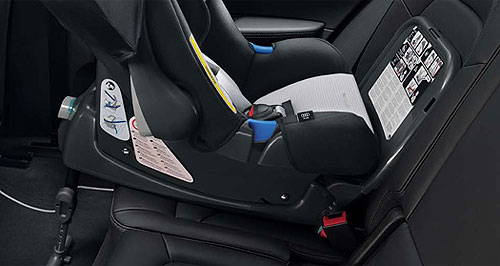Make / Model Search
News - General News - SafetyISOFIX finally approved for AustraliaFirst up: Holden's VF Commodore is one of a handful of vehicles to offer three ISOFIX anchorage points across its rear seat. Approval given for ISOFIX child restraint system with a top tether in Australia23 Sep 2014 By IAN PORTER AFTER more than a decade of agitating, the ISOFIX system for fitting child safety seats into vehicles has been approved for use in Australia. The system for attaching child safety seats to dedicated brackets built into the vehicle’s own seats promises to make fitting child safety seats much simpler. Previously, parents only had the option of feeding seatbelts through the frame of a safety seat in order to secure it in place, which according to a survey conducted by the Monash University Accident Research Centre, left more than 20 per cent of child safety seats incorrectly installed. However, under the new regulations only one type of ISOFIX seat will be permitted in Australia. In Europe, ISOFIX seats are available in two types – one with a top tether that reaches over the seat back to a third bracket on the parcel shelf or the floor, and another with a forward foot prop. Both are designed to prevent the seat tumbling forward. The modified Australian Design Rules (ADR) that have given the ISOFIX system the green light only permit the use of seats with a top tether, while seats with a forward foot prop have not been approved. The top tether strap has been a feature of the Australian/New Zealand child safety restraint standards since they were introduced in 1978. Parents will still be able to use seatbelts to secure an existing child safety seat in place. In fact, the new Australia/New Zealand standard for child safety seats mandates that an ISOFIX child safety seat must also be able to be secured using the seatbelts as authorities recognise that it may be some years before all new cars are fitted with ISOFIX brackets. The basic design of the ISOFIX system includes two brackets located at the base of the seat-back, between the seat-back cushion and the cushion on the bench. The top tether stretches from the back of the child safety seat to the parcel shelf in a sedan or to the floor in a hatchback, station wagon or SUV. GM Holden director of integration and safety Ian Butler said the company was ready to go as soon as the announcement was made, as it was apparent from June 2013 that ISOFIX seats would be eventually approved. “Out entire current range has been designed and built to be ISOFIX compliant,” he said. Mr Butler said the VF Commodore was one of only a handful of vehicles that offered three anchorage points across the vehicle’s rear seat, and added that it would be a “huge advantage” for those with larger families. “The ISOFIX child safety seat solution is expected to significantly reduce the risk of incorrect fitting of seats, as is commonly experienced using the belted child seat method currently widely used in Australia.” Mr Butler said Holden had been collaborating with child safety seat manufacturer Britax, and would have a specially designed ISOFIX seat available later this year. The approval of the ISOFIX system has taken some time because the assessment and approval of such systems has to pass through several government authorities or departments. The final decision to allow sale of ISOFIX child safety seats was made by the Australian Competition and Consumer Commission (ACCC) after a review of safety standards that started in November 2013. However, that review was sparked by changes in the joint Australian/New Zealand standard – AS/NZS 1754 – published in June 2013 by Standards Australia. “It is intended that this change will increase the likelihood of correct installation of child restraints,” said Colin Blair, chief executive of Standards Australia. “The revised standard maintains rigorous Australian requirements for restraining children in vehicles, but now allows ISOFIX-compatible lower attachment connectors to be included as an additional option in the design of certain types of child restraints,” Mr Blair said. In a paper the ACCC issued to support a request for feedback on the new standard, the commission published data which showed that, in 2005, 72 child passengers under the age of 16 were killed in motor vehicle accidents and “about a thousand” were seriously injured”. It said car accidents were the most common cause of injury and death of children aged between one and 14 years. The data also showed that, while parents believed installation of child restraint systems was easy, research had shown that more than 20 per cent of restraints were fitted incorrectly. The commission noted that the joint Australia/New Zealand standard for child safety seats was “widely recognised internationally as one of the most stringent child restraint standards in the world, with children in Australian Standards approved child restraints surviving motor vehicle crashes previously thought to be unsurvivable by overseas experts”.  Read more |
Click to shareGeneral News articlesResearch General News Motor industry news |











Facebook Twitter Instagram